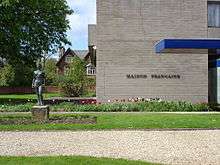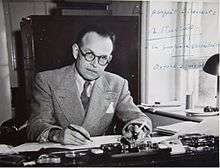Maison française d'Oxford
|
| |
| Type | French Research Centre in the Humanities and Social Sciences |
|---|---|
| Established | 1946 |
| Director | Anne Simonin |
| Location | Oxford, England, UK |
| Affiliations |
Network of French Research Institutes Established Abroad (IFRE), University of Oxford, Chancery of the Universities of Paris, French Ministry of Foreign and European Affairs, CNRS |
| Website | www.mfo.ac.uk |

The Maison Française d’Oxford (MFO, or just Maison Française locally) is a French research centre in the humanities and social sciences and a member of the Network of French Research Institutes Established Abroad (IFRE) by the French Ministry of Foreign and European Affairs and the French National Centre for Scientific Research (CNRS).
Overview
With the support of the Chancery of the Universities of Paris and the University of Oxford, the Maison Française works towards a better integration of French research in the humanities and social sciences in international networks, especially in the English-speaking world.
In 1999, it became a research centre of the Institute for the Humanities and Social Sciences (INSHS) of the CNRS, and, as such, it develops research programmes with academic institutions of the University of Oxford and other British universities.
Origin and historical context
The idea of establishing a French presence at the heart of the British academic world dates back to at least the beginning of the 20th century. It was defended in particular by the members of the French Club, which existed at the University of Oxford at the time and which brought together a community of francophile students.
However, it was not until after the Second World War, in more favourable circumstances, that this project was fully realised. The support that the United Kingdom had provided to the Free French had provoked a desire to consolidate the links between the two sides of the Channel, in cultural as much as academic terms.
The Maison Française was brought to life at the beginning of the academic year in 1946, thanks to the initiatives of the archaeologist Claude Schaeffer and under the guidance of Henri Fluchère, renowned academic, and a specialist of Shakespeare.
The current building was erected on an empty site on the north side of Norham Road in North Oxford, opposite Bradmore Road during 1961–2. It was designed by Jacques Laurent with Brian Ring, Howard & Partners.[1] From 1984 to 1991 Monica Charlot directed this institution that was targeting cultural exchange with Britain. She exploited the Oxford University environment to diversify the institutions approach.[2]

The name "Maison Française" was chosen in reference to the pavilions of the Cité Internationale Universitaire that opened in Paris in 1925 with the same peaceable ideals.
Mission and principles
The mission and the principles of the Maison Française, such as they are defined by the University of Oxford’s decree of 22 October 1946 that confirmed its foundation, ruled out the idea of it being a teaching institution in its own right. So, there was no question of establishing a new College, nor even a branch of the Alliance française.
The Maison Française was to constitute a new kind of institution, intended to promote academic, scientific and cultural exchange under the shared responsibility of the French Ministry of Foreign and European Affairs and the Universities of Paris and Oxford.
So, besides the establishment of a genuine library with a substantial collection, series of conferences and debates were organised where French literary and scientific figures — such as Albert Camus, François Mauriac, André Gide, Maurice Merleau-Ponty ou Jacques Lacan — came to present their research and to exchange with their British counterparts.
From the very beginning, the MFO organised exhibitions, concerts, theatre productions and cinema screenings, in the hope of more widely promoting cultural prestige in all its aspects.
Important changes in direction have been made since the 1980s. Given that the media provide increasing access to French cultural production, and that other institutions in both London and Oxford are dedicated to the diffusion of French language and culture, the MFO's activities as a cultural centre have become less significant.
At the moment, the missions of the Maison Française especially focus on academic co-operation and research. This evolution was clearly marked by the establishment of a CNRS research unit within the MFO in 1999. In 2015-2016, this research unit is composed of six researchers grouped into different areas of study: literature, theory of law and legal anthropology, history or classics.
The MFO is also home to a group of junior researchers (post-docs or research fellows) and research students, reading for Master's degrees or doctorates. The research students are affiliated to institutes and colleges of the University, and take part in the activities of the MFO. To that end, the MFO collaborates with several French research institutions and universities whose students spend periods of one month to an academic year there.
Scientific activities
The MFO hosts a team of senior researchers from the INSHS who conduct their own research at the University of Oxford but, more importantly, organise interdisciplinary programmes, conferences, seminars and other events in collaboration with members of the University. The MFO organises and/or hosts events ranging from single-speaker lectures or seminars, day-workshops on specialist topics, through to two- or three-day conferences.
Research programmes include:
- Classics
- Literature
- Theory of law and legal anthropology
- History
Resources
Library
The Maison Française houses a study and information centre devoted to French culture and society. Its collection is made up of 43,000 books, around 50 periodicals, and a video library composed of more than 1000 French movies. Its catalogue is linked to that of the University of Oxford.
Online resources
To promote access to the research and the events organised at the Maison Française, a large number of presentations are recorded and directly accessible via its website as podcasts or reports.
Sources
- Fluchère, Marie-Louise, La Maison Française à Oxford il y a 50 ans, self-published, 1996
- Vercoutter, Jean, « Notice sur la vie et les travaux de Claude Schaeffer-Forrer, membre de l'Académie », Comptes-rendus des séances de l'Académie des inscriptions et belles-lettres, 1989, vol. 133, n°1, p. 178-188
- Catto, Jeremy (s.d.), The History of the University of Oxford, Oxford University Press, 1994.
- MFO's archives (Activities report et archives files, Schaeffer in particular)
References
- ↑ Jennifer Sherwood and Nikolaus Pevsner,The Buildings of England: Oxfordshire, Penguin Books, 1974, page 318–319. ISBN 0-14-071045-0.
- ↑ Monica Charlot, Anne Corbett, 13 June 2005, The Guardian, Retrieved 29 September 2015
External links
- Official website
- Official page on the website of the Network of French Research Institutes Established Abroad
Coordinates: 51°45′57″N 1°15′33″W / 51.7657°N 1.2591°W